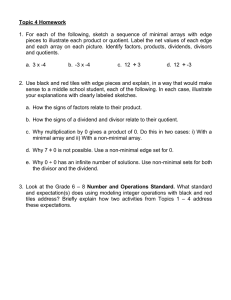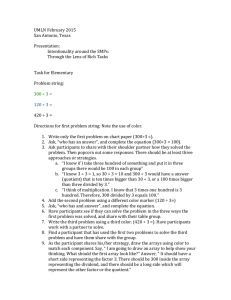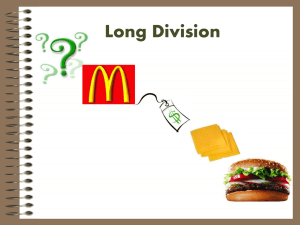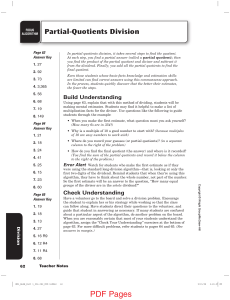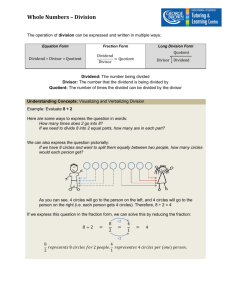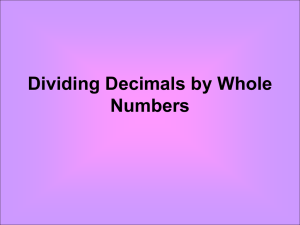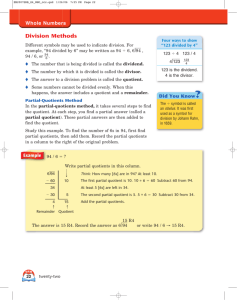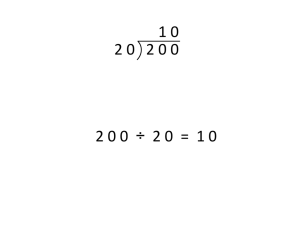CICI Grade 5 Division Using Area and Array Models
advertisement
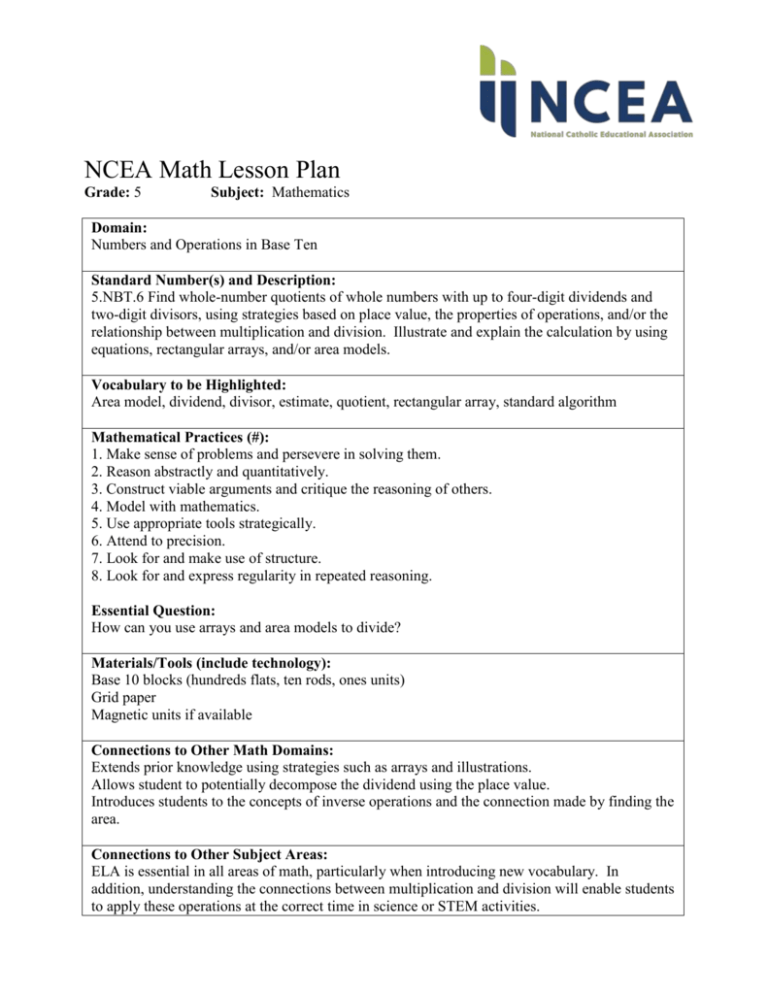
NCEA Math Lesson Plan Grade: 5 Subject: Mathematics Domain: Numbers and Operations in Base Ten Standard Number(s) and Description: 5.NBT.6 Find whole-number quotients of whole numbers with up to four-digit dividends and two-digit divisors, using strategies based on place value, the properties of operations, and/or the relationship between multiplication and division. Illustrate and explain the calculation by using equations, rectangular arrays, and/or area models. Vocabulary to be Highlighted: Area model, dividend, divisor, estimate, quotient, rectangular array, standard algorithm Mathematical Practices (#): 1. Make sense of problems and persevere in solving them. 2. Reason abstractly and quantitatively. 3. Construct viable arguments and critique the reasoning of others. 4. Model with mathematics. 5. Use appropriate tools strategically. 6. Attend to precision. 7. Look for and make use of structure. 8. Look for and express regularity in repeated reasoning. Essential Question: How can you use arrays and area models to divide? Materials/Tools (include technology): Base 10 blocks (hundreds flats, ten rods, ones units) Grid paper Magnetic units if available Connections to Other Math Domains: Extends prior knowledge using strategies such as arrays and illustrations. Allows student to potentially decompose the dividend using the place value. Introduces students to the concepts of inverse operations and the connection made by finding the area. Connections to Other Subject Areas: ELA is essential in all areas of math, particularly when introducing new vocabulary. In addition, understanding the connections between multiplication and division will enable students to apply these operations at the correct time in science or STEM activities. Writing: Students could develop mnemonic tools to remember the steps in developing the standard algorithm. Finance: Explain that profit is the amount of money made by providing goods and services. Gross profit is the amount earned after paying the cost of the item sold. Net profit is the money earned after paying all operating expenses, such as utilities, salaries, and rent. The gross profit for 48 items sold is $9,308. Divide to find the gross profit. Explain steps as you go. Catholic Identity Component: Noah’s Ark provides an abundance of numbers to work with. The volume of Noah’s Ark was approximately equal to 570 railroad cars. If the Ark was divided into 15 sections, how many railroad cars would be in each section? What would be the answer if the Ark was divided into 19 sections? What is the difference between your two answers? Resources (attachments): http://www.mathgoodies.com/standards/alignments/grade5.html https://grade5commoncoremath.wikispaces.hcpss.org/Assessing+5.NBT.6 Activities/Timeline: Students should have experience using arrays and have seen models for division. These models make connections between multiplication and division, focusing each being the opposite, or inverse, of the other. The goal will be to have students use these models with division using greater numbers. Introduction Draw a model showing 15 5. Ask students to share models with the class. The goal is to have them show how many groups of 5 are in 15. Look for these words. Scan for students who have drawn an array. Remind them of this method. You may have to hint that they should draw 3 rows of 5. This may also be done on the board. Additionally, use ten rods and one units to model this simple division problem. Activities Task 1: What is the estimate of 168 14? This is about 10. How did you find this estimation? Using compatible numbers 150 15 = 10 Task 2: Use an array to find the answer. A. Model 14. B. Make rows of 14 to model 168. C. Count the rows. There are 12 rows, each containing 14. Therefore, 168 14 = 12 Task 3: Use an area model. Remember, area = length x width Dividend = quotient x divisor Write dividend, 168, and the divisor, 14, in the rectangular area model. Write the difference, 28, in the second rectangle. Add 10 + 2. This is the final quotient. 10 + 2 = 12 Finally, bring it together. 168 14 = 12 On your own (review as a class): Find the quotient using an array model. Find the quotient using an area model. 224 16 323 17 Formative Assessment (what to look for, how/when to look): Use either an area or array model to find the quotient. 325 13 = 816 17 = 624 16 = 896 28 = 918 34 = 713 31 = 1680 15 = 2324 11 = 4802 14 = 2 0 Jill purchases 17 yards of fabric. She then cuts the fabric into 12 inch strips. How many strips does Jill make? The local bakery packs all buns in bags of 13 (a baker's dozen). If there were 585 buns made today, how many bags would be filled? Summative Assessment: Jacob is using a model to divide. He can begin the problem, but forgets what to do next. A. B. C. D. What is the division problem? Explain the next step. Demonstrate the division problem using the area model. Write a word problem that can be solved with this division problem.
